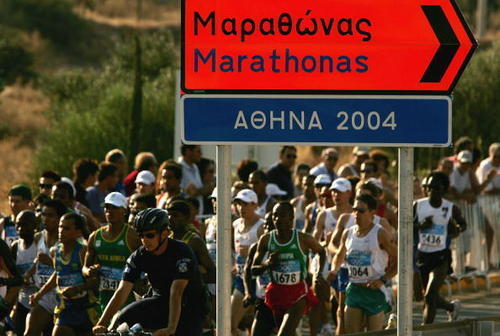Meet Sean Hartnett: Professor Marathon

He’s known as Professor Marathon for his phenomenal all-around knowledge of the 26.2-mile distance, so SPIKES had to find out more about Sean Hartnett: writer, photographer, course mapper, technical expert and tactical guru; and his longstanding love affair with the iconic event.
While working on a Ph.D. in Geography at the University of Wisconsin with a passion for British punk rock band The Clash, Harnett began writing concert and record reviews for his college newspaper The Daily Cardinal. It was a “dream gig”.
Yet far removed from the sweaty, beer-soaked rock venues he used to frequent, Sean had another passion: running, and it was in this direction, rather than for music, where his life would ultimately take him.
After three years of reporting on and interviewing performers like Joe Strummer, Ray Davies, Elvis Costello, and Neil Young, his editor discovered his marathon training and presented him with a glorious chance to spread the running gospel.
“We had some top notch people on the university team like Tim Hacker and Cathy Branta [the 1985 NCAA cross country champions] and John Easker and he [the editor] gave me the whole back page to write about it,” says Harnett.

Marathon man Hartnett has helped both Paul Tergat and Haile Gebrselassie
“It was a neat journalistic experience because they told me not to dumb down the material but to bring everyone up.”
For Hartnett, a man with an eye for detail, it was a chance he grabbed with both hands. He quickly established a reputation for excellence and bringing the sport alive.
So much so his writing had caught the eye of the one of the editors of the esteemed athletics bible Track and Field News.
“It was the days before the internet and the way colleges scouted out other team was to subscribe to their college newspaper,” he explains.
“I was attending an academic conference at Stanford and stopped by the Track & Field News headquarters. After chatting with some of the staff, they connected my name with some of the full-page race reports that a couple of college coaches had sent them.”
Impressed, T&FN started using his content nearly three decades ago. He first started covering marathons in 1987, and fascinated by the nuances of what he calls “the ultimate distance event" he quickly graduated to become a leading writer and expert on the event.
He has covered every US Olympic Trials marathon since 1992, started travelling to international races in 1999, and has reported on 39 of the 42 World Marathon Majors competitions since its inception in 2006.
From his background as a former athlete (he ran 13 marathons), writer, photographer, and with an eye for detail befitting his status as a Professor of Geography (who maps lakes as a day job), Hartnett’s reputation has grown within the marathon community.
So much so that coaches, agents and athletes sought out ‘Professor Marathon’ as an advisor, led by two-time Olympic 10,000m champion Paul Tergat, who knew that his transition to the marathon would be challenging.
“The first thing I told Paul was: the race is 50km or 30 miles long,” Hartnett says. “Paul answered, ‘I know my miles, and the marathon is only 26 miles,’ but I replied, 'yes, it is a 42km race on a perfect day with perfect conditions. If you have a tough course, it is a 44 and 45km effort.
“The 2004 Athens Olympic marathon [ran on an undulating course in oppressive heat] was like a 50km marathon.’ One of the key things is making sure the distance is not a factor in your performance, so you have to take the distance out of play.”

Longer than it looked: The Athens 2004 Olympic marathon
As his marathon career progressed, Tergat embraced this idea and lengthened his longest runs which had previously topped out at 30-35km. Before he set the world marathon record (2:03:55 in Berlin in 2003) he had upped his longest runs to 48km.
Besides the extra mileage, the marathon guru explains, a different mindset is needed to excel in marathon from the track approach. A fact he instilled in both Tergat and Haile Gebrselassie, who he later established a close relationship with.
“On the track, all the mental focus is about how you finish the race,” he says. “Racers worry about how they are going to beat people at the end of the race. Often on the track I bet those guys can’t even tell you what times they’ve run for the first kilometres.
"For the marathon you have to flip the race, so that 5km is 37km, 10km is 32km. The reason being, if you can’t push every last step of the marathon, the race beats you and you’ll throw minutes and seconds out the window. Marathon is one big arm wrestle. If you are lucky, you’ll finish the race winning the arm wrestle.”
His background as a Professor in Geography at the University of Wisconsin-Eau Claire has also made Hartnett a man in demand, for his intricate and detailed marathon map designs. Gebrselassie was said to have hung Hartnett’s map of the Berlin Marathon on his wall, to memorise the course before setting the first of his two world records there. Every gradient is astutely noted. Every marathon split diligently logged.
Hartnett is insistent such detail is required for the marathon runner to truly deliver their potential, in what he believes is a unique athletic challenge.
“The marathon is different to many other events because it is human beings against the limits of human performance,” he says. “We are all pushing at this frontier. For me, the marathon has replaced the 1500m as the ultimate distance event. I made a commitment to the marathon when it wasn’t that. I’ve seen it become the event.”
And in his own not-insignificant way, Hartnett made his own precious contribution to that marathon history.